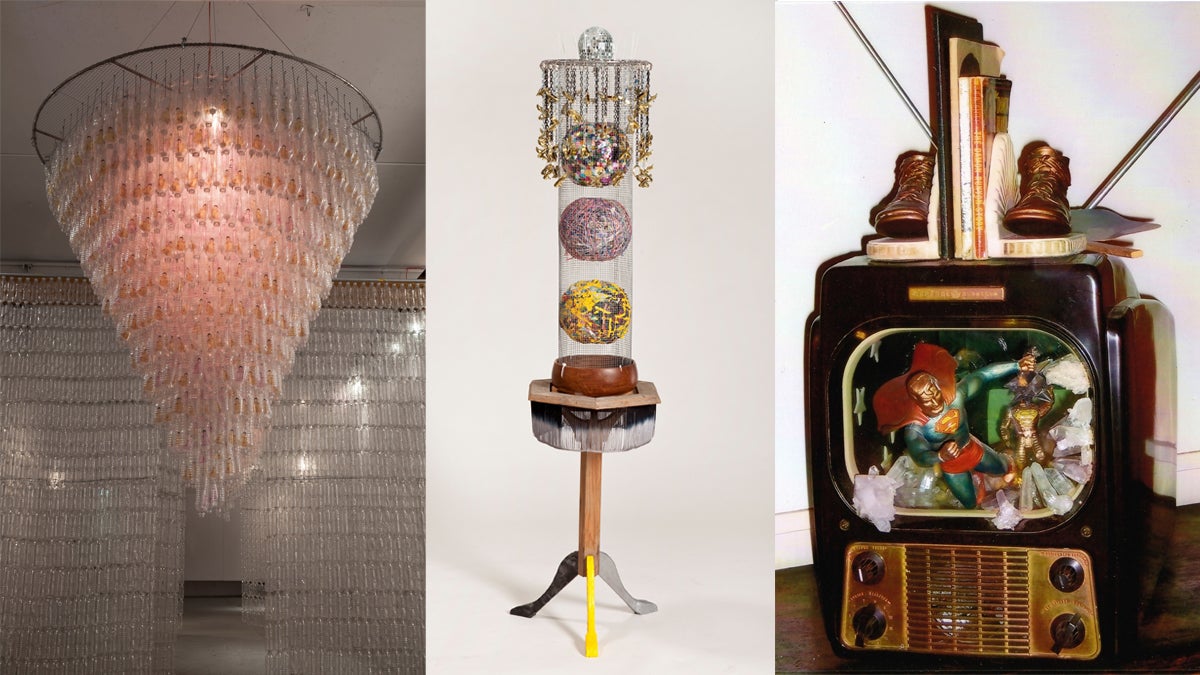Mass produced objects become art at Princeton exhibit

From left to right, Buddha Chandelier by Willie Cole, Dancing Shoes by Donna Payton, and Superman Leaving Home by Valerie Young. (Photos courtesy of Arts Council of Princeton)
The more our world fills up with junk, the more artists make supplies out of the detritus of our society. There are so many artists working with found object media now that there are sub-classifications within the genre.
There are artists who gather material from Dumpsters, distinguished from artists who scour antique stores and flea markets for a finer kind of junk. Then there are artists who prefer to use junk with a personal connection, creating from the refuse of their own lives.
In its exhibition MASSassembly – Mass Production to Mass Appeal, on view at the Paul Robeson Center for the Arts through June 7, the Arts Council of Princeton is focusing on art constructed of objects that have been mass produced – televisions, water bottles, plastic toys and figurines.
“Stuff – it’s everywhere,” writes Arts Council Artistic Director Maria Evans in her introduction to the catalog. “In our attics, garages, basements.”
For artists, it’s even more acute, because they are given fabric, spools, brushes, toys by generous souls anticipating that the objects will be used in future masterworks.
“In our mass-produced, throw-away society, mixed media artists are the ultimate recyclers, living in a world of endless art supplies,” continues Evans. “
Artist Willie Cole has been working with mass produced plastic objects since his boyhood in the 1960s. On a dollar-a-week allowance, the Newark native visited S. Klein’s Department Store and bought model kits of plastic cars and superheroes. He’d start by putting them together according to the directions but make them his own by adding thread, beads, toothpicks, straws and the plastic apparatus that held the parts together in the kit – launching his successful art career.
When his son turned 11 and had amassed a sneaker collection, Cole got the idea to collect women’s shoes – preferable to sneakers because the heels could represent, for example, teeth. The artist began using matches, bicycle and toilet parts as the building blocks for his sculpture.
Water bottles especially excite him. He’s made automobiles, complete with motors, out of plastic water bottles. At the Arts Council exhibit his “Buddha Chandelier” is made from 2,000 Poland Spring water bottles. Each bottle contains a pink or gold image of a Buddha printed on clear nylon film.
Cole practiced Buddhism for many years and continues to live by the Buddhist principle of oneness — the belief that all things are connected.
Valerie Young, a Hopewell artist, combines cultural icons to create unexpected conversations. “Superman Leaving Home” has an action figure of the superhero from Krypton bursting out of the confines of a mid-century television console. Bronze baby shoe bookends, a Damon Runyon paperback and a fly swatter help to convey the era when Superman was king.
In Young’s “Opus 30”, wind instruments, watch parts, bulbs and balls become a nocturnal scape in a universe of twinkling orbs.
Andy Epstein’s assemblages share a likeness with the boxes of mid century artist Joseph Cornell, with suspended orbs and mysterious minutiae – tiny bottles, springs, thread spools, razor blades, dice, computer keys, buttons, objects from nature (leaves, shells, pine cones, maple seedling), paint brushes, toys and electronic parts.
His titles add to the mystique, with a suggestion of science: “Archival Lapse of Reason,” “The Mechanics of Presence,” “Game of Chances,” “The Calculus of Metaphors.”
Donna Payton’s installations include everything from ping-pong balls to papered balloons and carpet spools. “For Whom the Bell Tolls” includes, Tupperware lids, plastic chains, and a garment made with gel medium in which rubber bands are embedded.
Music can be heard in the gallery, emanating from Payton’s “Dancing Shoes”, a circle of dangling brass shoes, James Birnbaum, a collector of Payton’s work, composed music for the piece.
Payton arrived at the gallery with a single earring, made from a skeleton key, dangling from a lobe. There are 191 other keys incorporated into “Soul Key”, a work of fiber.
“I’m a material girl,” she says, explaining her love for using non-traditional objects instead of paint.
The key collection came from her grandfather. “He was an organized hoarder, like me,” says Payton, whose collections are neatly shelved in labeled boxes in her Millstone studio.
In addition to the skeleton keys there are skate keys and even a sardine-can key, attached with jewelry crimps and loose leaf rings.
So what is “Soul Key” all about?
“Everyone is looking for the key to happiness, success, love, friendship, a good job, attracting a soul mate,” says Payton. “We’re all trying to fit different locks, or maybe there is a universal key. That’s why there are different religious philosophies and beliefs. Everyone is searching for the answer, the key.”
MASSassembly – Mass Production to Mass Appeal is on view at the Arts Council of Princeton’s Paul Robeson Center for the Arts through June 7. www.artscouncilofprinceton.org
WHYY is your source for fact-based, in-depth journalism and information. As a nonprofit organization, we rely on financial support from readers like you. Please give today.





